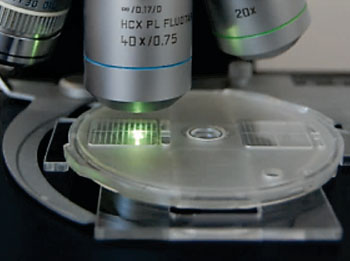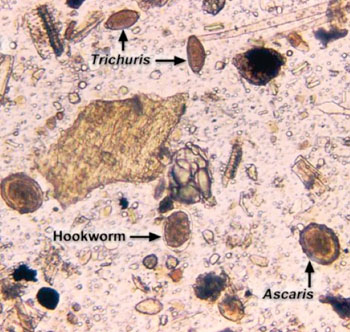Alternative Methods Tested for Detection of Soil-Transmitted Helminths
|
By LabMedica International staff writers Posted on 12 Jun 2014 |

Image: The Mini-FLOTAC device for the detection of helminthic eggs (Photo courtesy of Prof. Giuseppe Cringoli).

Image: Photomicrograph of Ascaris sp., Trichuris sp., and hookworm eggs in a fecal sample (Photo courtesy of Dr. Mae Melvin).
The commonly used diagnostic technique for the detection of soil-transmitted helminths (STH) is the Kato-Katz method, but it has low sensitivity arising mainly from the nonrandom distribution of eggs in stool and day-to-day variation in egg output.
An alternative to the Kato-Katz method is a new flotation and translation-based technique, which was compared to the Kato-Katz method and exhibits greater sensitivity for detecting STH species such as Ascaris lumbricoides, Trichuris trichiura, and hookworm.
Scientists at the London School of Hygiene and Tropical Medicine (UK) working with colleagues in East Africa, collected stool samples were from 652 children attending 18 schools in Bungoma County (Kenya). Helminths infections were diagnosed by the Kato-Katz and Mini-FLOTAC coprological methods. The diagnostic performance of the methods was further assessed in terms of positive predictive value (PPV, proportion of true positive results detected), negative predictive value (NPV, proportion of true negative results detected), and accuracy (proportion of readings that have given a valid result) based upon modeled prevalence, sensitivity and specificity.
Overall, 93 of the 657 samples were positive for at least one STH species on both tests (14.2%), 485 samples tested negative for any STH species on both tests (73.8%), 45 samples tested positive with Kato Katz and negative with Mini-FLOTAC (6.8%), and 34 tested negative with Kato Katz and positive with Mini-FLOTAC (5.2%). When the scientists combined the results from consecutive days, children were reclassified as infected if they were positive on either day, and uninfected if testing negative on both days: 23.5% of the 132 children included were classified as positive for any STH species by both tests, 60.6% as negative by both tests, 9.1% as positive by Kato Katz only, and 6.8% by Mini-FLOTAC only. Sensitivity analysis revealed the cost of case detection for any STH decreased nonlinearly as prevalence rates increased and was influenced by the number of samples collected.
The authors concluded that their evaluation shows that the Kato-Katz and Mini-FLOTAC methods were comparable to one another in diagnostic sensitivity, yet Kato-Katz afforded greater cost-effectiveness. They encourage the wider use of simulation, cost-effectiveness and field studies to evaluate the cost-effectiveness of diagnostic and sampling strategies for STH surveillance in a variety of settings and for the wider surveillance of different neglected tropical diseases. The study was published on May 8, 2014, in the journal Public Library of Science Neglected Tropical Diseases.
Related Links:
London School of Hygiene and Tropical Medicine
An alternative to the Kato-Katz method is a new flotation and translation-based technique, which was compared to the Kato-Katz method and exhibits greater sensitivity for detecting STH species such as Ascaris lumbricoides, Trichuris trichiura, and hookworm.
Scientists at the London School of Hygiene and Tropical Medicine (UK) working with colleagues in East Africa, collected stool samples were from 652 children attending 18 schools in Bungoma County (Kenya). Helminths infections were diagnosed by the Kato-Katz and Mini-FLOTAC coprological methods. The diagnostic performance of the methods was further assessed in terms of positive predictive value (PPV, proportion of true positive results detected), negative predictive value (NPV, proportion of true negative results detected), and accuracy (proportion of readings that have given a valid result) based upon modeled prevalence, sensitivity and specificity.
Overall, 93 of the 657 samples were positive for at least one STH species on both tests (14.2%), 485 samples tested negative for any STH species on both tests (73.8%), 45 samples tested positive with Kato Katz and negative with Mini-FLOTAC (6.8%), and 34 tested negative with Kato Katz and positive with Mini-FLOTAC (5.2%). When the scientists combined the results from consecutive days, children were reclassified as infected if they were positive on either day, and uninfected if testing negative on both days: 23.5% of the 132 children included were classified as positive for any STH species by both tests, 60.6% as negative by both tests, 9.1% as positive by Kato Katz only, and 6.8% by Mini-FLOTAC only. Sensitivity analysis revealed the cost of case detection for any STH decreased nonlinearly as prevalence rates increased and was influenced by the number of samples collected.
The authors concluded that their evaluation shows that the Kato-Katz and Mini-FLOTAC methods were comparable to one another in diagnostic sensitivity, yet Kato-Katz afforded greater cost-effectiveness. They encourage the wider use of simulation, cost-effectiveness and field studies to evaluate the cost-effectiveness of diagnostic and sampling strategies for STH surveillance in a variety of settings and for the wider surveillance of different neglected tropical diseases. The study was published on May 8, 2014, in the journal Public Library of Science Neglected Tropical Diseases.
Related Links:
London School of Hygiene and Tropical Medicine
Latest Microbiology News
- Handheld Device Deliver Low-Cost TB Results in Less Than One Hour
- New AI-Based Method Improves Diagnosis of Drug-Resistant Infections
- Breakthrough Diagnostic Technology Identifies Bacterial Infections with Almost 100% Accuracy within Three Hours
- Innovative ID/AST System to Help Diagnose Infectious Diseases and Combat AMR
- Gastrointestinal Panel Delivers Rapid Detection of Five Common Bacterial Pathogens for Outpatient Use
- Rapid PCR Testing in ICU Improves Antibiotic Stewardship
- Unique Genetic Signature Predicts Drug Resistance in Bacteria
- Unique Barcoding System Tracks Pneumonia-Causing Bacteria as They Infect Blood Stream
- Rapid Sepsis Diagnostic Test Demonstrates Improved Patient Care and Cost Savings in Hospital Application
- Rapid Diagnostic System to Detect Neonatal Sepsis Within Hours
- Novel Test to Diagnose Bacterial Pneumonia Directly from Whole Blood
- Interferon-γ Release Assay Effective in Patients with COPD Complicated with Pulmonary Tuberculosis
- New Point of Care Tests to Help Reduce Overuse of Antibiotics
- 30-Minute Sepsis Test Differentiates Bacterial Infections, Viral Infections, and Noninfectious Disease
- CRISPR-TB Blood Test to Enable Early Disease Diagnosis and Public Screening
- Syndromic Panel Provides Fast Answers for Outpatient Diagnosis of Gastrointestinal Conditions
Channels
Clinical Chemistry
view channel
Carbon Nanotubes Help Build Highly Accurate Sensors for Continuous Health Monitoring
Current sensors can measure various health indicators, such as blood glucose levels, in the body. However, there is a need to develop more accurate and sensitive sensor materials that can detect lower... Read more
Paper-Based Device Boosts HIV Test Accuracy from Dried Blood Samples
In regions where access to clinics for routine blood tests presents financial and logistical obstacles, HIV patients are increasingly able to collect and send a drop of blood using paper-based devices... Read moreMolecular Diagnostics
view channel
RNA-Based Blood Test Detects Preeclampsia Risk Months Before Symptoms
Preeclampsia remains a major cause of maternal morbidity and mortality, as well as preterm births. Despite current guidelines that aim to identify pregnant women at increased risk of preeclampsia using... Read more
First Of Its Kind Test Uses microRNAs to Predict Toxicity from Cancer Therapy
Many men with early-stage prostate cancer receive stereotactic body radiotherapy (SBRT), a highly precise form of radiation treatment that is completed in just five sessions. Compared to traditional radiation,... Read moreNovel Cell-Based Assay Provides Sensitive and Specific Autoantibody Detection in Demyelination
Anti-myelin-associated glycoprotein (MAG) antibodies serve as markers for an autoimmune demyelinating disorder that affects the peripheral nervous system, leading to sensory impairment. Anti-MAG-IgM antibodies... Read moreHematology
view channel
New Scoring System Predicts Risk of Developing Cancer from Common Blood Disorder
Clonal cytopenia of undetermined significance (CCUS) is a blood disorder commonly found in older adults, characterized by mutations in blood cells and a low blood count, but without any obvious cause or... Read more
Non-Invasive Prenatal Test for Fetal RhD Status Demonstrates 100% Accuracy
In the United States, approximately 15% of pregnant individuals are RhD-negative. However, in about 40% of these cases, the fetus is also RhD-negative, making the administration of RhoGAM unnecessary.... Read moreImmunology
view channel
Stem Cell Test Predicts Treatment Outcome for Patients with Platinum-Resistant Ovarian Cancer
Epithelial ovarian cancer frequently responds to chemotherapy initially, but eventually, the tumor develops resistance to the therapy, leading to regrowth. This resistance is partially due to the activation... Read more
Machine Learning-Enabled Blood Test Predicts Immunotherapy Response in Lymphoma Patients
Chimeric antigen receptor (CAR) T-cell therapy has emerged as one of the most promising recent developments in the treatment of blood cancers. However, over half of non-Hodgkin lymphoma (NHL) patients... Read morePathology
view channel
Advanced Imaging Reveals Mechanisms Causing Autoimmune Disease
Myasthenia gravis, an autoimmune disease, leads to muscle weakness that can affect a range of muscles, including those needed for basic actions like blinking, smiling, or moving. Researchers have long... Read more
AI Model Effectively Predicts Patient Outcomes in Common Lung Cancer Type
Lung adenocarcinoma, the most common form of non-small cell lung cancer (NSCLC), typically adopts one of six distinct growth patterns, often combining multiple patterns within a single tumor.... Read moreTechnology
view channel
Pain-On-A-Chip Microfluidic Device Determines Types of Chronic Pain from Blood Samples
Chronic pain is a widespread condition that remains difficult to manage, and existing clinical methods for its treatment rely largely on self-reporting, which can be subjective and especially problematic... Read more
Innovative, Label-Free Ratiometric Fluorosensor Enables More Sensitive Viral RNA Detection
Viruses present a major global health risk, as demonstrated by recent pandemics, making early detection and identification essential for preventing new outbreaks. While traditional detection methods are... Read moreIndustry
view channel
Cepheid and Oxford Nanopore Technologies Partner on Advancing Automated Sequencing-Based Solutions
Cepheid (Sunnyvale, CA, USA), a leading molecular diagnostics company, and Oxford Nanopore Technologies (Oxford, UK), the company behind a new generation of sequencing-based molecular analysis technologies,... Read more
Grifols and Tecan’s IBL Collaborate on Advanced Biomarker Panels
Grifols (Barcelona, Spain), one of the world’s leading producers of plasma-derived medicines and innovative diagnostic solutions, is expanding its offer in clinical diagnostics through a strategic partnership... Read more























